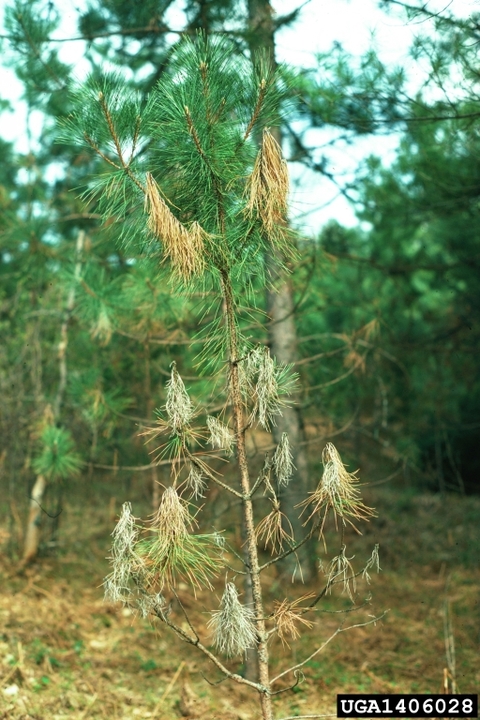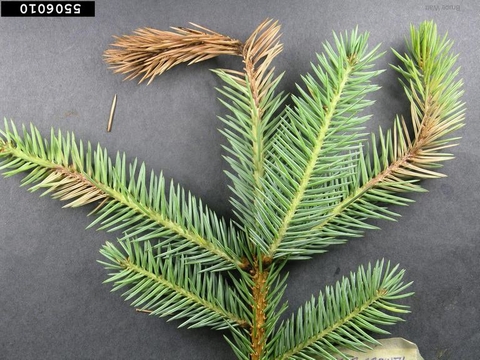Quick facts
-
Sirococcus blight of conifers is most common on small landscape trees or on understory trees below infected, mature-sized trees.
-
Damage to large trees is confined to lower branches.
-
The infection can kill seedlings.
-
In Minnesota, Sirococcus blight only causes noticeable problems in years with consistently cool, wet weather.
How to identify Sirococcus blight of conifers
In summer, infected needles, shoot tips and one year old twigs wither, turn brown and fall off.
Infections on expanding shoots often cause the shoot to curl downward in a shepherd's crook.
Infected red pine needles often droop obviously.
On mature trees, infection is often limited to the lower branches.
Tiny, brown-to-black bumps appear on newly infected shoots and needles. These bumps are called “pycnidia” and they produce fungal spores.
On spruce, pycnidia are most common on the young branches. On red pine, they are mostly found under needle sheaths.
Trees affected by Sirrococcus blight in Minnesota
Sirococcus blight of conifers is most common on:
Red pine (Pinus resinosa)
Blue spruce (Picea pungens)
Other species that can be affected include:
Ponderosa pine (Pinus ponderosa)
White fir (Abies concolor)
Tamarack (Larix laricina)
Norway spruce (Picea abies)
White spruce (P. glauca)
Black spruce (P. mariana)
Red spruce (P. rubens)
Jack pine (P. banksiana)
Mugo pine (P. mugo)
Scots pine (P. sylvestris)
Douglas fir (Pseudotsuga menziesii)
How does Sirococcus blight survive and spread?
Sirococcus blight of conifers is caused by the fungus Sirrococcus conigenus.
The Sirococcus blight fungus overwinters in infected needles and shoots.
Spores are spread during wet periods in spring and summer when temperatures are 60 to 68 degrees F. The most severe infections occur in years with longer than normal wet periods.
The spores spread by splashing or dripping water to start infections on young, growing plant parts.
Infections occur on, or next to, the base of new needles and then spread to shoots.
Eventually, the lesions expand, killing the shoots.
The infection may move into one-year-old twigs and kill them.
In a mature tree, infection is typically limited to the lower branches and does not severely damage the health of the tree.
Infected young trees can become badly disfigured or killed.
How to manage Sirococcus blight of conifers
Prune to remove infected shoots and branches during dry weather.
At planting time, space trees according to their mature size. Space is important to provide enough sunlight and air movement and promote drying of branches and foliage.
If Siroccocus shoot blight has been a regular problem in your area, plant resistant or immune species including:
Balsam fir (A. balsamea)
Austrian pine (P. nigra)
Eastern white pine (P. strobus)
Have your soil tested to check magnesium levels. If your soil is lacking in magnesium, fertilize your tree with the recommended rate according to test results. Soil can be tested at the University of Minnesota Soil Testing Laboratory.
If trees have a history of infection with Sirococcus blight and weather forecasts predict long periods of cool, wet weather, a fungicide can be applied to protect new growth. A fungicide with chlorothalonil as an active ingredient should be applied in spring while new shoot tips and needles are growing. Follow label instructions for timing of additional applications.
CAUTION: Mention of a pesticide or use of a pesticide label is for educational purposes only. Always follow the pesticide label directions attached to the pesticide container you are using. Remember, the label is the law.
Reviewed in 2024




